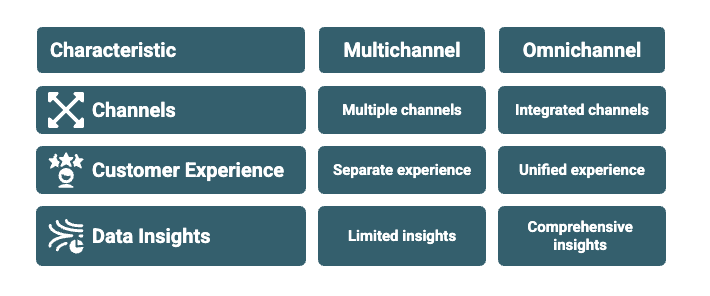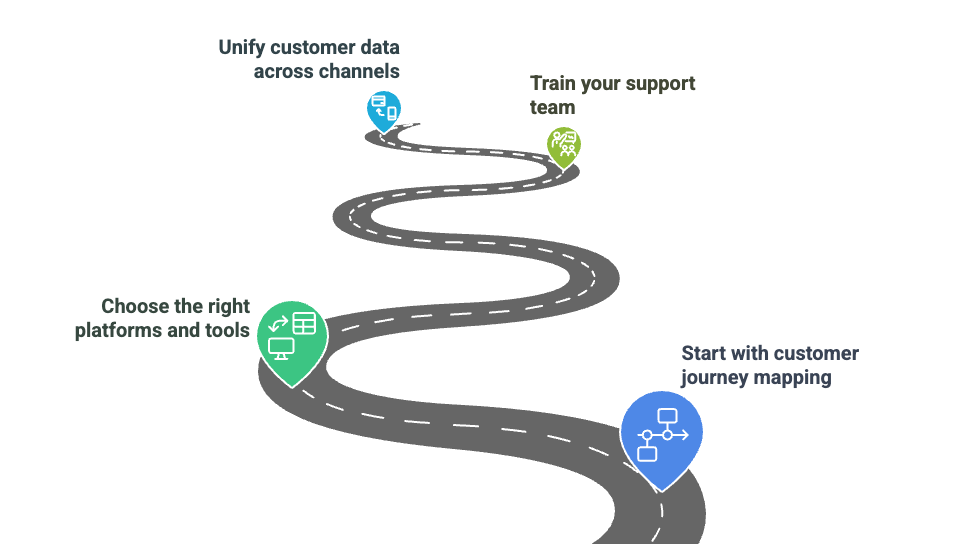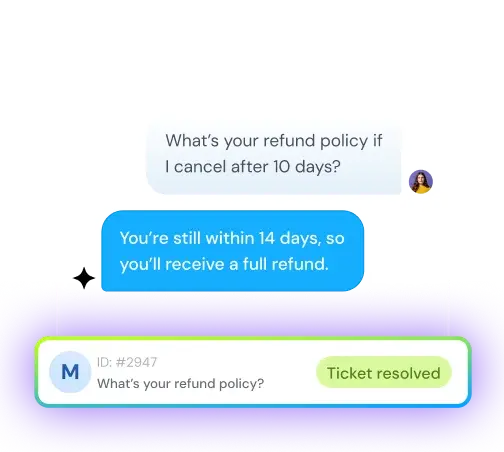Benefits of omnichannel customer service in E-commerce (2025 Guide)
Sneha Arunachalam
Jun 05, 2025

Today’s customers don’t just want great service — they expect it to be seamless across every channel. One minute they’re messaging your brand on Instagram, the next they’re firing off an email or chatting with a bot on your website. If your support team can’t keep up, they’ll simply move on. This is exactly where omnichannel customer service steps in.
In this blog, we’ll break down what omnichannel support really means, how it’s different from multichannel, and why e-commerce brands need to embrace it to stay competitive in 2025. We’ll also look at the biggest benefits of an omnichannel strategy — and how to get started.
What is omnichannel customer service?
Omnichannel customer service is all about delivering support across every channel your customers use — whether it’s email, live chat, social media DMs, SMS, or even phone calls — and making it all feel like one smooth, continuous experience.
The magic word here is “seamless.”
It’s not just about being present on multiple platforms — that’s what multichannel support does. The real power of omnichannel lies in connecting those platforms so your team has complete visibility into every interaction, no matter where it started.
Let’s say a customer first sends you a question via Instagram DM, follows up with an email the next day, and later jumps on your website’s live chat. With a true omnichannel system, your support team sees the full conversation history in one place — from the first message to the last. That way, customers don’t have to repeat themselves, and agents aren’t left guessing.
It’s a smarter, more human way to support modern shoppers — and one of the biggest benefits of omnichannel customer service is how it reduces friction at every step of the customer journey.
In short? Omnichannel = one connected conversation, no matter where it happens.
Omnichannel vs. multichannel: What’s the real difference?
These two terms often get used interchangeably, but they’re not the same — and the distinction matters if you want to offer top-tier support.
Here’s a quick breakdown:

Multichannel support simply means your business is available in more than one place. That’s a good start — but it’s not enough. Without integration, each channel is like a separate island. Customers might have to repeat themselves, and your support agents won’t have the full picture.
Omnichannel support, on the other hand, connects all those islands into one ecosystem. Your agents get instant access to the customer’s history across all channels, allowing for more personalized, relevant, and efficient conversations.
And that’s where the real benefits of omnichannel customer service come into play — from faster resolution times to stronger customer relationships and improved loyalty.
When done right, omnichannel customer service delivers more than just convenience—it turns your support team into a powerful engine for customer satisfaction and business growth.
Why omnichannel support is crucial for E-commerce

E-commerce moves fast. Customers browse from their phones, compare prices on laptops, and message support while commuting. If your service isn’t fluid, you're going to lose them.
Here’s why omnichannel customer service is becoming a must-have for e-commerce brands in 2025:
1. Today’s customers use multiple channels — often at once
A shopper might discover your brand via an Instagram ad, message a product question on Facebook, get an order confirmation via email, and follow up via website chat. This is normal behavior now. If your systems aren’t talking to each other, you’re creating friction.
Omnichannel support ensures that every interaction feels like part of the same conversation — no matter the platform.
2. Speed + context = loyalty
Customers expect fast replies — but also personalized ones. When agents can see the customer’s history (what they bought, what they asked before, how they reached out), they can resolve issues faster and make the customer feel seen.
That’s not just good service — it builds trust and loyalty.
3. You can recover poor experiences in real time
Things go wrong. Orders get delayed. Payments fail. Packages arrive damaged.
But how you handle it is what counts. With omnichannel support, you can proactively reach out, respond faster, and make it right — all while showing customers that you actually know who they are.
8 benefits of omnichannel customer service in E-commerce (that actually matter)
Let’s be real: e-commerce moves fast. And customers? They move even faster. The best thing you can do for your business is meet them where they are and keep the experience connected. Here’s what the benefits of omnichannel customer service look like when they show up in the real world.
1. Customers don’t have to keep explaining themselves
You know that awkward moment when a customer says, “I already told the other person this…”
Yeah — not great.
- With omnichannel, your team sees the whole story, no matter where it started
- Customers can hop between chat, email, and DMs without losing the thread
- No more asking for order numbers three different times
People feel heard — and that alone goes a long way.
2. You actually earn loyalty (instead of hoping for it)
Loyalty isn’t just about discounts or loyalty programs. It’s about how you show up for people when they need help.
- Customers get the same level of care no matter the channel
- Your team can follow up personally because they have full context
- The experience feels like it’s from a brand that genuinely cares
This is where long-term relationships really start.
3. Your team works smarter, not harder
Omnichannel isn’t just good for customers — your support team breathes easier too.
- Everything lives in one view: chats, emails, tickets, you name it
- Agents don’t have to bounce between tools or copy-paste info
- It cuts down on repeat work and helps resolve stuff way faster
Less chaos for your team = better support for your customers.
4. Personalization doesn’t feel forced
When support feels like a one-size-fits-all script, people check out. But when it’s relevant and human? That’s when people remember it.
- Your agents can greet people by name and know their last interaction
- Recommendations or updates can be tied to what they actually bought
- You can respond in a way that feels like a real conversation
Personalization should feel like you’re paying attention — not like you’re reading a helpdesk prompt.
5. Support becomes a part of the buying journey
Here’s the truth: support doesn’t just happen after the sale anymore. People ask questions before they click “buy.”
- Shoppers message you on IG or live chat with product questions
- Fast replies = fewer abandoned carts
- You can close more sales just by showing up on time, in the right place
One of the sneaky-powerful benefits of omnichannel customer service? It helps you sell better, not just support better.
6. You get data that actually means something
Disconnected systems mean you only see part of the picture. When it’s all linked? You can really learn from it.
- You know which channels bring in the most questions (or complaints)
- You see how fast issues get resolved — and where they stall
- You can start spotting patterns and improving your whole experience
The insights are clearer — and way more useful.
7. It levels up how people see your brand
Support is often the only time someone interacts with a real person at your company. How that goes? It sticks.
- A consistent voice and tone across all platforms builds trust
- People don’t feel like they’re dealing with a robot army
- They remember the helpful, human experience — and that shapes your brand
It’s not just about solving issues. It’s about showing people who you are.
8. You can grow without the wheels falling off
The more your business grows, the messier support can get — unless you’ve set things up right from the start.
- Onboard new agents quickly with everything in one place
- Automate the boring stuff so humans can handle the real conversations
- Scale across channels without things breaking
It’s one of the biggest benefits of omnichannel customer service: growth without the mess.
Real-world examples of the benefits of omnichannel customer service in E-commerce
Ready to see the Benefits of Omnichannel Customer Service in action? Some brands are absolutely crushing it — and their results show exactly why this approach works so well.
Case study: Online fashion retailer
Sephora doesn't just talk about omnichannel — they live it every day. They've mastered connecting their physical stores with digital experiences in ways that feel totally natural to customers. Their mobile app is where the magic happens, letting shoppers try products virtually, check reviews, and get personalized recommendations whether they're browsing from their couch or standing in a store aisle.
The secret sauce? Their loyalty program. It's not just about points and rewards (though who doesn't love those?) — it's the backbone that helps them track what customers love and deliver marketing that actually makes sense.
The numbers don't lie: shoppers who visited Sephora's website within 24 hours after an in-store trip were three times more likely to buy something, and they spent 13% more when they did. That's not just nice — that's money in the bank.
Oasis Fashion took things a step further by giving store staff iPads loaded with customer info and preferences. Can't find that top in your size? No problem — they'll order it for home delivery right on the spot. This smart move boosted their profits by a whopping 48% in just one year.
Case study: Subscription box service
The subscription box world has exploded, now reaching nearly 6 million US shoppers. But here's the challenge — most customers stick around for only 125 days. Yikes!
These services face a unique situation: their customers typically have more money and education than average, and they expect personalized experiences with lightning-fast problem solving. Meeting these high standards requires a seriously good omnichannel system connecting phone, chat, email, SMS and social media.
Smart subscription companies focus on two things. First, they build specific retention programs where trained agents work to win back customers who've left. Second, they use their connected data to spot patterns in what people buy and where they get frustrated.
4 steps to implement an omnichannel customer service strategy

Setting up an omnichannel system doesn't have to be overwhelming. With some smart planning and the right approach, you can build something that truly connects all your customer touch points. Here's how to make it happen.
Step 1: Start with customer journey mapping
The first step? Map out how your customers actually move through their relationship with you. This isn't just some academic exercise — it shows you exactly where people might get stuck or need help.
Take a good look at:
- Every possible way customers reach you (website, social media, email, phone)
- How they jump between these different channels
- Where the experience gets clunky or frustrating
- What they're feeling at each step along the way
This gives you something powerful — the ability to see your business through your customers' eyes. That perspective changes everything.
Step 2: Choose the right platforms and tools
Your tech choices make or break your omnichannel strategy. You need a platform that brings all your communication channels under one roof. The best systems give you:
- A complete view of every interaction across all channels
- Smooth handoffs between different communication methods
- Smart automation for those routine questions
- Rock-solid security for all that valuable customer data
Don't just go with the flashiest option. Ask about training, support, and how well it'll grow with you. Your perfect platform today might feel painfully limited next year if you don't plan ahead.
Step 3: Train your support team
Great tech alone won't cut it. Your team needs to know how to use it effectively. They should understand:
The entire customer journey from start to finish How to sound like your brand across every channel Ways to use those unified customer profiles for personalized help The art of smooth channel transitions without making customers repeat themselves
Regular training keeps everyone sharp as technology and customer expectations keep evolving.
Step 4: Unify customer data across channels
The magic happens when you tear down those data walls between departments. Build customer profiles that include everything — purchase history, browsing patterns, past conversations, you name it.
Your helpdesk becomes the beating heart of this system, giving everyone access to the complete customer story. This turns fragmented interactions into one coherent conversation that builds relationships and drives growth.
Conclusion
The numbers don't lie — omnichannel customer service completely changes how e-commerce businesses connect with shoppers. It's miles ahead of those clunky multichannel approaches that keep customers repeating themselves over and over. Your customers expect to bounce between touchpoints without missing a beat, and they want personalized support every step of the way.
The payoffs are pretty incredible. Customers get faster answers, personalized help, and smooth experiences no matter how they reach out. Your business wins too — more productive agents, higher sales, and customers who stick around. Companies doing omnichannel right keep about 89% of their customers, while businesses with weak approaches hold onto just 33%. That difference is huge!
These aren't just fancy promises. Brands like Sephora have actually seen the results — higher conversion rates, bigger orders, and stronger customer relationships.
Ready to jump in? Start by mapping out where your customers interact with you, pick the right platform, train your team properly, and bring all your customer data together in one place. Sure, it takes some planning, but think about what you're getting: happier customers, smoother operations, and more money coming in. For any e-commerce business trying to stand out in today's crazy-competitive market, that's definitely worth the effort.
Quick summary: Benefits of omnichannel customer service in E-commerce: 2025 Guide
Today's e-commerce customers expect seamless support across all channels. Whether they're messaging on Instagram, emailing about an order, or using live chat, they want one continuous conversation with your brand.
What makes omnichannel different?
Unlike multichannel support (offering multiple disconnected channels), omnichannel customer service integrates all platforms into one unified system where your team sees the complete customer journey.
Key benefits of omnichannel customer service:
- Customers never repeat themselves across channels
- Creates genuine loyalty through personalized interactions
- Support teams work more efficiently with unified tools
- Personalization feels natural, not forced
- Support becomes part of the e-commerce sales process
- Provides actionable data insights
- Elevates your brand perception
- Enables scalable growth
Real-world success stories like Sephora show the impact: customers who engage across channels spend 13% more, and companies with strong omnichannel strategies retain 89% of customers versus just 33% for businesses without this approach.
Implementing omnichannel support starts with mapping customer journeys, selecting the right platform, proper team training, and unifying customer data across all touchpoints.
For e-commerce brands competing in 2025, omnichannel customer service isn't just nice to have—it's essential for growth and customer retention.
Frequently Asked Questions
Omni customer service means providing seamless support across all channels—like phone, chat, email, and social media—where customers can switch between them without repeating themselves. It unifies customer interactions into one smooth experience. This approach improves satisfaction and speeds up problem resolution.
Agents have access to the full conversation history across channels, they don’t have to ask the same questions repeatedly or waste time searching for info. This speeds up resolutions and reduces frustration.
The 4 C’s of omnichannel are:
- Customer – Putting the customer at the center of all channels and interactions.
- Content – Delivering consistent, relevant content across every channel.
- Context – Using customer data and behavior to personalize the experience.
- Channel – Integrating multiple communication channels seamlessly for smooth transitions.
Multichannel simply means being available on multiple platforms, but these channels typically operate in silos. Omnichannel takes it further by integrating all channels so information flows between them. With multichannel, a customer might have to repeat their issue when switching channels, while omnichannel preserves the conversation history across all touchpoints.
Yes! Many omnichannel platforms offer scalable solutions designed for businesses of all sizes. Starting with just a few core channels and growing gradually can keep costs manageable.
